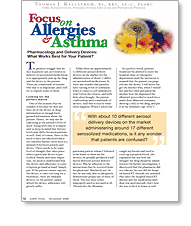 |
|||||
|
|
Spring 2007 New Guidelines Will Help You Breathe Easy Pharmacology and Delivery Devices: What Works Best for Your Patient? Asthma Management: Barriers to Care
|
|
|
By Thomas J. Kallstrom “Respiratory therapists are recognized as patient advocates and educators. One of the greatest challenges therapists face is how to appropriately pair the drug and the aerosol delivery device to the patient. Respiratory therapists work hard to determine that the medication, the aerosol device, and the patient's understanding of the correct and proper usage of both match up. This article in their professional magazine, AARC Times, talks about the RT's role in helping you better understand how to use and administer your asthma medication. The greatest struggle that we face in patient care as it relates to delivery of aerosolized medications is to appropriately pair up the drug and the device to the patient. There are a multitude of reasons why that is so important, and I will try to explore some of them. Looking for the
perfect match Today there are approximately 10 different aerosol delivery devices on the market for the administration of about 17 different aerosolized medications. Is there any wonder that patients have varying levels of confusion when it comes to self-administration? Given the choices, and with little aforethought, the patient could end up with a multitude of devices. And that is exactly what often happens. When I asked one particular patient whom I followed in his home to show me his devices, he proudly produced a half dozen different aerosol delivery devices. Was he adherent to the instructions that he received from his physician? Absolutely not. In fact he was only able to adequately demonstrate proper use of three of them. The rest were either improperly used or not used at all. Therein lies the dilemma. In a perfect world, patients would not be allowed to leave the hospital clinic or emergency department until the instructor is assured that the patient can properly use the device. I will never forget the mother who, when I visited her and her child and asked the mother how she dispensed the albuterol, proceeded to reach for a multi-dose albuterol container, drew up 3 mL’s of the drug, and put it in the nebulizer cup. After I caught my breath and tried to cover up a perplexed look, she explained this was how she thought the drug should be administered. On further investigation, I discovered that the pharmacist did not educate her nor did the hospital-based RT. Instead, she assumed that since the hospital-based RT did not mix the medication (unit dose was used instead), that’s how she was to do it at home as well. The take-home point is that the clinician must keep a critical eye on the device and patient match. This can be accomplished by asking, and taking the time to observe the patient’s preparation and administration technique. Unfortunately, this type of scenario may not be all that infrequent in the home—or the hospital as well. In fact, albuterol, which is the most commonly administered aerosolized respiratory medication, is second only to insulin as the most common drug implicated in health system medication errors.1 Correcting the errors These errors are surprising but
do illustrate the importance of
proper education and follow-up
with the patient, whether they are
just starting to use the device or
have been using it for some time.
Probably no one would argue the
fact that the device needs to be
tailored to the patient. Arecent
evidence-based analysis published
in Chest found that when the
patient uses the device correctly,
the efficacy is equivalent.3 However,
to me the take-home point
from this study was that we must
make the following considerations
when prescribing aerosol medication
and the devices that will
deliver the medicine. They include: Once all of these questions are answered, the clinician should have a better basis for deciding which device is best suited for the patient. The thing to remember is that patient adherence is directly related to perceived ease or difficulty in using a particular device. We need to work to assure that our patients are given the appropriate device, and we must continue to keep ourselves current on the newer devices being prescribed today. • References Upcoming Resource About the author |
|

